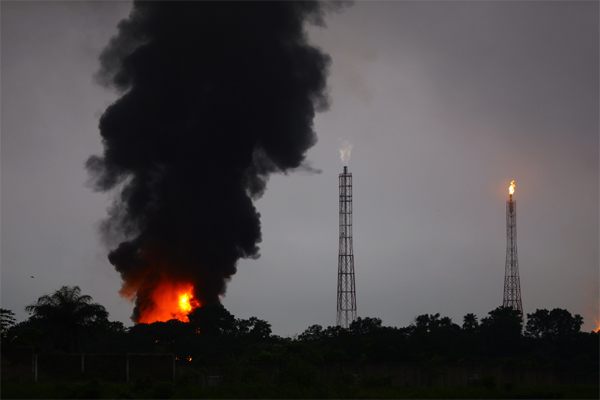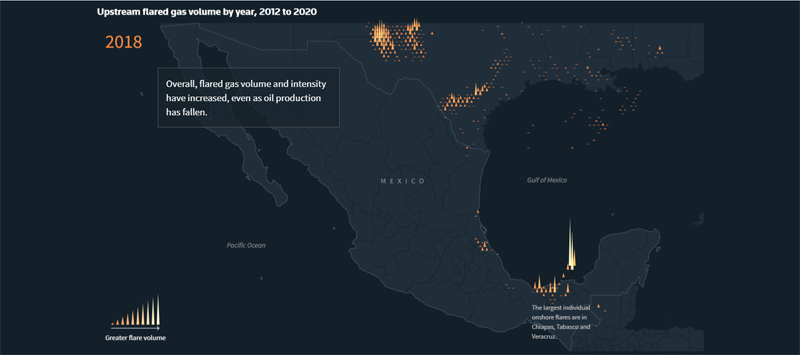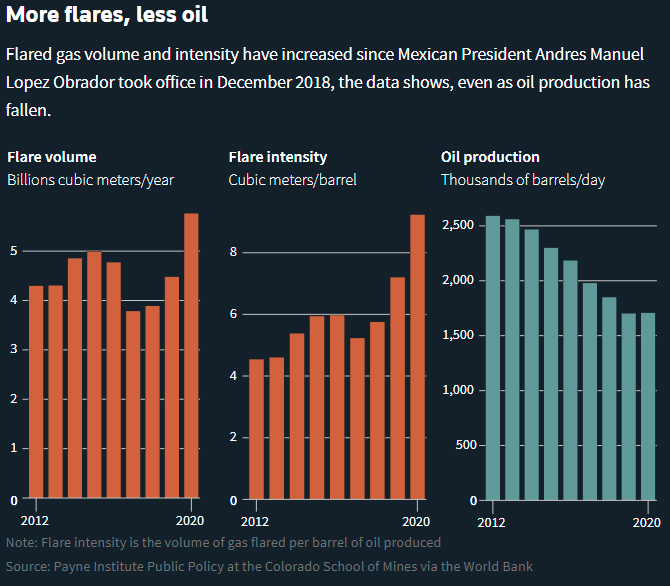Mexico derailing its climate change pledges

Stefanie Eschenbacher, Reuters
MPROCESADOR DE GASCACTUS, Mexico
EnergiesNet.com 02 25 2022
It never gets completely dark in Colonia El Carmen, home to Mexico’s largest natural gas processing center, in the poor southern state of Chiapas.
After sunset, a red glare emanates from flares dotted around the Cactus gas processing center, run by state oil company Petroleos Mexicanos (Pemex).
The complex is unable to process the vast volume of gas emitted as a byproduct of oil production and disposes of the excess by flaring it, a widespread industry practice that scientists said is detrimental to the environment.
Burning the excess gas is cheaper than investing in infrastructure to capture, process and transport it for other uses. But in addition to carbon dioxide, flaring releases methane, a more potent greenhouse gas.
NASA satellite images of flare sites across Mexico, analyzed for Reuters by scientists at the Earth Observation Group of the Colorado School of Mines, showed that gas flaring has dramatically increased under Mexican President Andres Manuel Lopez Obrador.

The volume of gas flared leapt by 50% from 3.9 billion cubic meters (bcm) when Lopez Obrador took office in 2018 to 5.8 bcm in 2020, the data showed, putting Mexico among the world’s top 10 flarers.
And preliminary data collected for the first 10 months of 2021 suggest Mexico is on track to break 2020’s record of flaring activity, the Colorado School of Mines team found, with February registering an all-time monthly high.
The new data suggests that in spite of signing an international pledge to reduce methane emissions, Mexico is moving in the opposite direction from a global push to rapidly reduce greenhouse gas production.
Pemex declined to comment. Mexico’s presidency, energy and environmental ministries, and environmental regulator did not respond to repeated requests for comment on this report.

emitted by gas flares as infrared emissions at global upstream oil and gas facilities.
Source: The Payne Institute Public Policy at the Colorado School of Mines
Mexico is among 34 countries – as well as 51 oil companies – that have signed a World Bank-backed pledge endorsers to cut routine flaring to zero by 2030.
“There’s been a significant increase in both the number of individual flare sites and the volume of gas that is being flared in Mexico,” said Christopher Elvidge, the principal investigator of the Colorado School of Mines team.
The satellite data is the only daily global survey that collects information on the temperature, location and size of gas flares from the oil industry.
The 2021 preliminary data has not previously been reported and the analysis of the 2020 figures provided the first detailed picture of where flaring is taking place in Mexico.
This data showed that Chiapas and the neighboring states of Tabasco and Veracruz are the epicenter of a dramatic rise in gas flaring, close to several population centers.

Pemex last year acknowledged that high levels of flaring and outdated, inadequate infrastructure was one of its top ten challenges.
The world’s most heavily indebted state oil company is under pressure from Lopez Obrador to raise crude production on the cheap with little private investment.
The president, a left-leaning nationalist, wants to make Mexico self-sufficient in energy. But since he took office, flaring has soared, the satellite data showed, while oil production fell as Pemex relies on maturing fields that contain higher concentrations of gas.
Lopez Obrador has argued it will take time to turn Pemex around after his government inherited a company devastated by decades of mismanagement and plundering.
Set for another record year
While the scientists estimate that the increased flaring emits millions of additional tons of greenhouse gases, Pemex does not disclose overall emissions, nor how much gas is flared, vented or otherwise wasted.
“The high – and rising – flaring activity has both local and global impacts,” said Tamara Sparks, a researcher who studied the data, referring to pollution in local communities and the effects on global warming.
“New flare sites popping up, like we saw in 2020 in Mexico, may not operate as efficiently as a well-established, steadily operating flare,” Sparks said, adding it could lead to proportionately more emissions of methane.
The 2020 data, the most detailed visualization of Mexico’s flaring to date, showed that the number of flares rose to 195 from 141 two years earlier, with the biggest increases registered in Chiapas, Tabasco and Veracruz.
It also showed that three of the five largest flares in the country were near to several villages, including Colonia El Carmen.
Resident’s ‘Hell’
Residents of Colonia del Carmen – home to roughly 4,000 – listed six major environmental incidents linked to flaring since July in an official complaint to Pemex, stamped as received on Sept. 30. Residents said they are awaiting Pemex’s reply.

Photographs in the complaint showed oil residue in a lagoon used for fishing, on streets and cars. Residents cited several flares so large they caused “panic” and heat so intense it led to the cancellation of an open air cinema for children.
Residents said in 15 separate interviews that they have suffered from headaches or coughing, and children complained of irritated eyes and itching skin.
Others pointed to a strong, lingering sulfur-like smell, ash rains and contaminated soil.

Pemex’s Cactus gas processing center in Reforma municipality in Chiapas, Mexico. (Edgard Garrido / Reuters)

in Colonia El Carmen, Chiapas state, Mexico, October 19, 2021. (Edgard Garrido / Reuters)
“It’s like hell,” said Orbilio Garcia, whose family land was expropriated by the government to expand Pemex operations, but still lives nearby. “When our son was born, we got so concerned about his health that we moved a little further away. But we don’t have enough to leave the area and start over elsewhere.”
Reuters could not independently verify the events in the complaint and also could not determine if the health issues the residents described were linked to flaring.
At ground level
Reuters visited Chiapas and Tabasco for several days in October, counting more than 30 sites on guarded Pemex property where gas and other hydrocarbons were being burnt – fires that would be registered by the satellite images.
More than a dozen of these fires near Colonia del Carmen, which is nestled between the Cactus and Nuevo Pemex gas processing centers, were unlike the controlled flaring from nearby industrial stacks.

the air at the Pemex Cactus gas processing center. (Edgard Garrido / Reuters)

Reuters captured images of these huge flames coming from pits filled with liquid, which were sending billowing clouds of black smoke into the air.
Eduardo Prud’homme, an energy consultant who spent two decades working at Pemex, said the color, movement and shape of the flames and smoke in the Reuters footage indicated the burning of gas mixed with dirtier hydrocarbons that release more CO2, likely from abandoned wells or leaking infrastructure.
“This is not normal. Not in this size,” said Prud’homme, who also worked at the energy regulator and the National Center for Control of Natural Gas.
Reuters could not independently confirm his analysis. Pemex and the manager at the Cactus gas processing center did not respond to requests for comment.
Pemex is legally obliged to inspect, maintain and repair its infrastructure, including abandoned wells, but Mexican energy experts – including five current and former regulators – said it was difficult to impose punishment.
Rosanety Barrios, who spent almost two decades at the energy regulator and energy ministry, said sanctioning the state oil company, which contributes about a quarter of the federal budget, “doesn’t seem likely” since the government regards it as its “top priority” towards energy independence.
“Pemex is under pressure to produce and public finances are also under pressure,” Barrios said.
‘Highly insufficient’ policies
The lack of investment and maintenance is worsening the flaring as Lopez Obrador instead prioritizes exploration and production activities, five regulatory sources and two Pemex petroleum geologists told Reuters.
To meet Mexico’s international emission targets, the president is pinning his hopes on greater use of hydroelectric power and reforestation.

Climate Action Tracker, a site run by independent scientists, rates Mexico’s policies to be “highly insufficient” in meeting a goal of holding global warming to well below 2 degrees Celsius – let alone the stricter target of 1.5 degrees agreed at a U.N. climate conference in Paris in 2015.
Lopez Obrador’s policies will lead to rising – rather than falling – emissions, it concluded.
The two Pemex geologists with access to reserves data, who asked not to be identified because the information is sensitive, said the challenges to reduce flaring are only going to get greater.
Not only is Pemex extracting as much oil as it can from mature fields – when more gas tends to come to the surface – but the unique geological characteristics of new oil fields include more gas, they said.
In a statement to Reuters, the national hydrocarbons regulator said it had no projection for future flaring because there was no clarity over the geological characteristics of fields to be tapped in the coming years and infrastructure that would be put in place to utilize gas.
In its last quarterly report, Pemex acknowledged that 13% of gas that comes to the surface as a byproduct of oil production is currently wasted – much higher than the 2% limit set by regulators.
Graphics by Chris Canipe / Edited by Dan Flynn and Julia Wolfe from Reuters
reuters.com 02 23 2022












